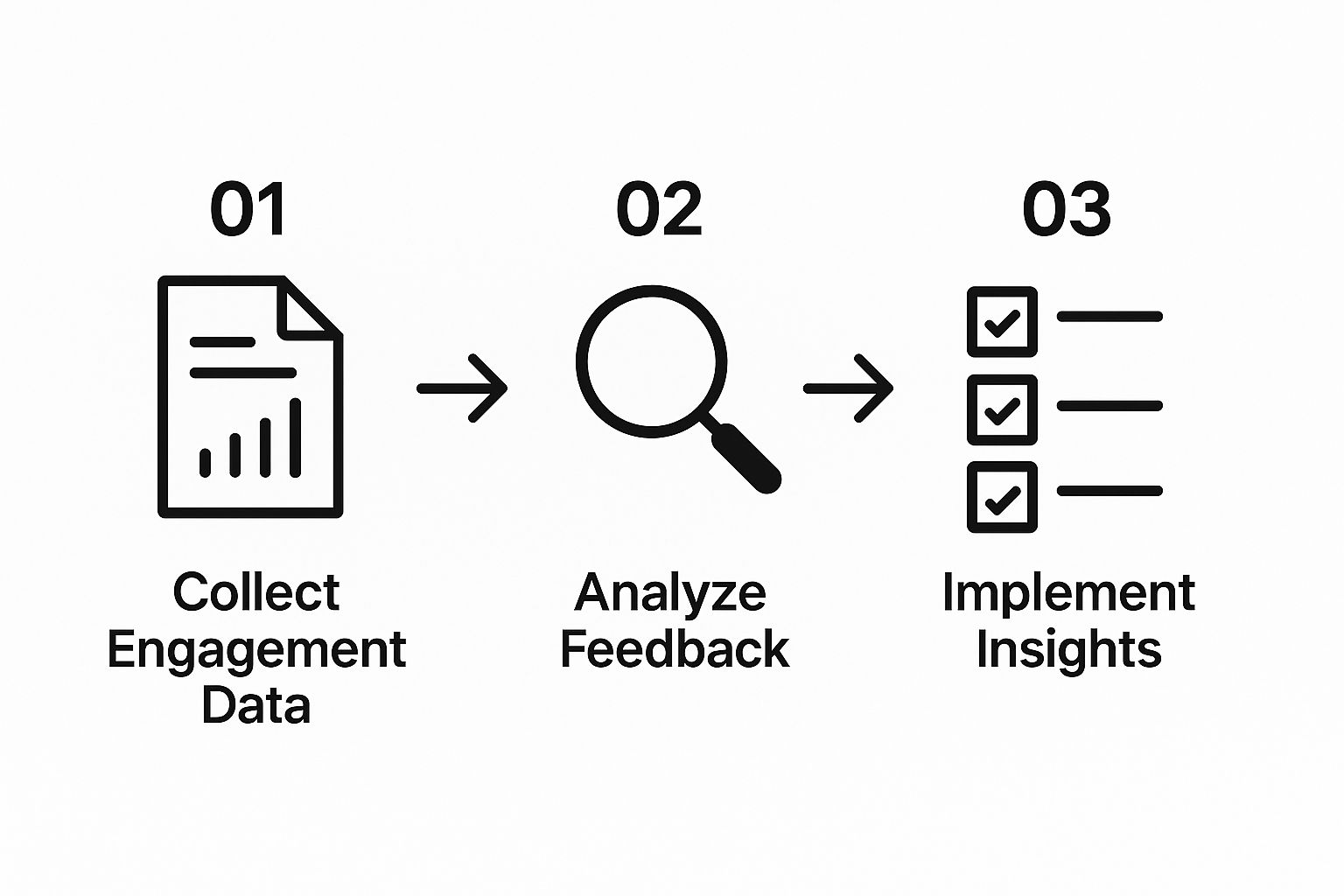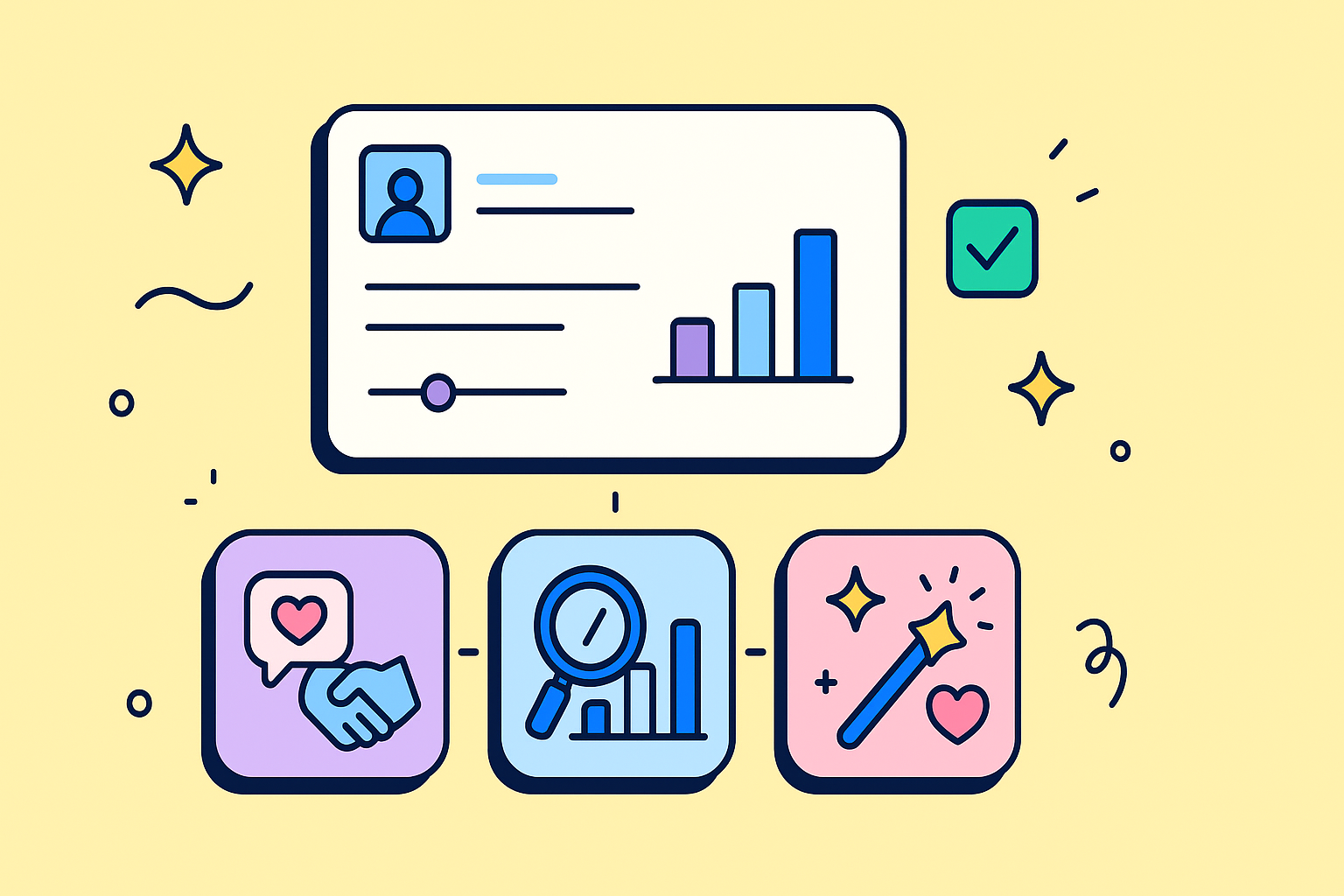To get a real handle on customer churn, you need to zero in on three things: engaging with customers before they have a problem, digging deep into your data, and delivering an experience they won’t forget. It really boils down to understanding why customers are leaving and using that knowledge to build loyalty long before they even think about walking away.
The Hidden Costs of Losing a Customer

Customer churn isn’t just a number on your monthly report. It’s a silent killer, slowly draining your revenue, chipping away at your brand’s reputation, and capping your long-term growth. The immediate loss of a subscription is obvious, but the real damage runs much deeper, sending ripples through your business that can throw everything off balance.
Too many companies write off churn as an unavoidable cost of doing business. That’s a dangerous mindset. It completely misses how quickly the problem can spiral. A seemingly small monthly churn rate can easily become a massive annual headache, trapping you on a hamster wheel of constantly trying to find new customers.
The Compounding Effect of Monthly Churn
When you look at how monthly churn adds up over a year, you start to see why retention is so critical. Even a “low” monthly churn of 5% means you’re losing nearly half (46%) of your customers in a single year. It gets worse. If that monthly churn creeps past 10%, your annual churn rate skyrockets to over 70%. Think about that—you’d have to replace the vast majority of your customer base every twelve months just to stand still.
This constant scramble to replace lost customers blows up your Customer Acquisition Cost (CAC), since finding new customers is always more expensive than keeping the ones you have. It also damages your brand’s credibility. A revolving door of customers signals instability and dissatisfaction to anyone considering your product.
The real danger of churn isn’t just lost revenue. It’s the loss of momentum, the erosion of team morale, and the slow drain on resources that could have been invested in innovation and growth.
Beyond the Numbers: A Strategic Overview
Fighting churn effectively isn’t about finding a single magic bullet. It requires a coordinated effort across your entire organization, built on a solid foundation of understanding and action.
Before we dive into specific tactics, let’s break down the core pillars of a solid churn reduction strategy. These are the fundamental areas you need to focus on to build a business that customers stick with.
| Core Pillars of Churn Reduction |
| :————————- | :——————————————————————————————— | :————————————————————————- |
| Pillar | Focus Area | Key Objective |
| Proactive Engagement | Consistent communication, educational content, celebrating milestones | Move from reactive support to actively helping users succeed. |
| Deep Data Analysis | Analyzing usage patterns, support tickets, and direct feedback | Identify at-risk customers and understand the “why” behind their behavior. |
| Unforgettable Experience | Seamless onboarding, empathetic support, and frictionless product interactions | Build loyalty at every touchpoint, making your service indispensable. |
These pillars aren’t just concepts; they are the building blocks of a churn-proof business. Getting these right is what separates companies that thrive from those that are constantly struggling to keep up.
This guide will walk you through the practical, real-world steps to put these principles into action and build a business customers genuinely don’t want to leave.
Diagnosing Why Your Customers Are Leaving
Before you can even think about building a strategy to reduce customer churn, you need to put on your detective hat. Solving the churn puzzle starts with a simple, crucial step: finding out why your customers are actually leaving in the first place. Jumping to conclusions or, even worse, relying on assumptions is a fast track to wasting time and money on “solutions” that miss the mark entirely.
A proper diagnosis is part art, part science. It involves digging into the quantitative signals—the cold, hard numbers—and then layering on qualitative insights that give you the human story behind the data. This dual approach is how you turn vague hunches into a clear, evidence-backed understanding that can actually guide your retention efforts.
This flow captures the core idea: you collect data, you analyze feedback, and then you put what you’ve learned into practice.

This really drives home the point that diagnosing churn isn’t a one-and-done project. It’s a continuous cycle of listening, learning, and acting on what your customers are telling you.
Uncovering Quantitative Churn Signals
Start with the data you already have. Your analytics and CRM platforms are absolute goldmines of information that can flag at-risk customers long before they hit the cancel button. These are your early warning signs.
Here are a few key metrics to get you started:
- Product Usage and Engagement: Is there a noticeable drop in logins? Are key features being ignored? A slump in activity is often one of the most reliable predictors of churn.
- Support Ticket Trends: Are certain customers suddenly flooding your support team? A spike in tickets, especially for the same recurring problems, is a huge red flag for growing frustration.
- Subscription Changes: Are customers downgrading their plans or removing seats? That’s a direct signal they’re questioning the value they get and are actively looking to spend less.
These numbers tell you what is happening, but they rarely explain why. That’s where you need to get qualitative.
Gathering Qualitative Insights
To get the human story behind the metrics, you have to actually talk to your customers. While the data points to a problem, it’s the qualitative feedback that explains it. Gathering these insights is where you build real empathy and get to the core of your customers’ pain points.
Here’s a sobering thought: only 1 in 26 unhappy customers will actually complain. The other 25 just leave. This means any feedback you do get is incredibly precious—it likely represents the feelings of a much larger, silent group.
Here are a few powerful ways to collect this kind of feedback:
- Exit Surveys: When a customer cancels, ask them why. Keep it short and to the point. A simple multiple-choice question with an optional open-ended field can give you both structured data and rich, contextual stories.
- One-on-One Interviews: Pick up the phone and call a few recently churned customers. A personal conversation shows you care and can uncover subtle issues a survey would completely miss. Offering a small gift card for their time is a nice touch.
- Review and Social Media Monitoring: Pay close attention to what people are saying on review sites and social platforms. This unsolicited feedback is often brutally honest and can shine a light on widespread issues.
Segmenting Your Data for Deeper Understanding
Not all customers are created equal, and they certainly don’t churn for the same reasons. To get a truly clear picture, you have to segment your churn data. Figuring out which customer groups are most likely to leave is a critical part of the diagnosis and can be accomplished with effective market segmentation strategies.
Try slicing your churn data by a few different dimensions:
- Customer Persona: Are certain user types leaving more often than others?
- Subscription Plan: Is your mid-tier plan bleeding customers while your enterprise plan is rock solid?
- Acquisition Channel: Do customers who came from a specific marketing campaign churn faster?
- Customer Tenure: Do most of your customers leave within the first 90 days, or is it after their first year?
This level of detail helps you zero in on where your retention efforts will have the biggest impact. For instance, high churn in the first 90 days probably signals an onboarding problem. Churn after a year, on the other hand, might suggest you’re failing to demonstrate long-term value.
Building a Proactive Retention Strategy

Once you’ve figured out why customers are leaving, it’s time to flip the script. Stop playing defense. A reactive approach means you’re only dealing with people who already have one foot out the door.
The best way to cut down churn is to build a strategy that fosters loyalty from the very first click. This means creating an environment where customers feel seen, successful, and supported long before the thought of leaving ever crosses their mind.
It all boils down to a few core pillars: a knockout onboarding experience, ongoing education, and communication that feels personal and timely. The goal is to get momentum from day one and keep it going, making your product and your relationship with the customer something they can’t imagine living without.
Design an Onboarding Experience That Delivers Instant Value
First impressions are everything. If your onboarding is clunky, confusing, or just throws users in at the deep end, you’ve practically lost them already. The data backs this up: 68% of users say they’d stick with a business that puts real effort into quality onboarding and education. Those first 90 days are your make-or-break window to prove your product’s worth.
Your onboarding needs to be a guided tour to that first “aha!” moment—the instant a user truly gets how your product solves their problem.
Here’s how to get it right:
- A Clear Welcome Series: Don’t just fire off one email. Create a short sequence that highlights key features, points to helpful resources, and sets clear expectations for what they’re about to accomplish.
- Interactive Product Tours: Ditch the passive video. Walk users through the initial setup and a few core actions right inside the app. This builds confidence and muscle memory from the start.
- Personalized Onboarding Calls: For your high-value accounts, nothing beats a one-on-one call with a customer success manager. It’s your chance to understand their specific goals and tailor the experience directly to what they need to achieve.
The aim isn’t just to show them how to use the features, but to prove why it’s going to make their life easier.
Drive Engagement Through Continuous Education
Onboarding is just the starting line. To keep customers locked in for the long run, you have to give them ways to keep learning and growing with your product. I’ve seen plenty of customers churn not because a product was bad, but because they felt they weren’t getting their money’s worth out of it—they simply didn’t know how to unlock its full power.
Continuous education turns regular users into power users, and power users almost never churn.
A customer who feels confident and competent with your product is a customer who sees its value every single day. Education transforms uncertainty into loyalty.
Here are a few proven ways to provide that ongoing learning:
- Targeted Webinars: Host live sessions on specific features or advanced strategies. Think “Advanced Reporting Techniques” for your seasoned users who want to dig deeper.
- A Robust Knowledge Base: Build out a comprehensive, easily searchable library of tutorials and how-to guides. This lets users help themselves whenever they want.
- In-App Nudges and Tips: Use subtle tooltips or pop-ups to point out underused features that would be a perfect fit for a user based on their activity.
Implement Personalized Communication Campaigns
Generic, one-size-fits-all emails make customers feel like just another number on a spreadsheet. When you send campaigns triggered by specific behaviors, you’re showing them you’re paying attention to their journey. This is how you shift from a purely transactional relationship to a relational one.
Think about the key moments where a personal touch could make all the difference:
- Celebrate Milestones: Automatically send a congratulatory email when a user hits their one-year anniversary or completes 100 tasks. It’s a small thing that shows you’re celebrating their success.
- Re-engage Inactive Users: If someone hasn’t logged in for 30 days, trigger a friendly “just checking in” email. Offer some help, point them to a new feature, or share a relevant guide.
- Offer Proactive Support: Notice a user visiting the same help article over and over? Have a support agent reach out directly to see if they’re stuck. You’re solving a problem before they even have to ask.
These small, personal touchpoints add up, building a powerful sense of connection and showing that you’re truly invested in their success. That’s the kind of loyalty that lasts.
Boosting Loyalty with Superior Customer Experience
No matter how proactive your strategies are, customers will eventually need help. It’s just a fact of doing business. Those moments—when something goes wrong or a question pops up—are where loyalty is either cemented or completely shattered. A standout customer experience isn’t just a nice extra anymore; it’s one of your strongest defenses against churn.
Every single interaction is a fresh opportunity to prove your value and build a relationship that’s more than just a transaction. When customers feel genuinely looked after, they’re far more likely to stick with you, even when they hit a few bumps in the road.
The cost of getting this wrong is honestly staggering. A single poor experience is enough to drive 17% of customers away for good. In the US alone, that adds up to an estimated $136.8 billion in losses from churn that could have been avoided. On the flip side, simply improving the customer experience with fast, personal service can cut churn by about 15%. You can discover more customer retention insights on Sprinklr.
Create a Seamless Omnichannel Support System
Today’s customers expect to get help on their own terms. That means they want to reach out on whatever channel they prefer—be it email, live chat, phone, or social media—without the headache of repeating their entire story every time. This is the heart of an omnichannel support system.
An omnichannel approach creates a consistent, connected experience. A customer might start a conversation on your website’s live chat, follow up later with an email, and then get a call from a support agent who has the full history right in front of them. This simple change eliminates a massive point of friction and makes the customer feel like they’re dealing with one unified team, not a bunch of disconnected departments.
Here’s what this looks like in practice:
- Centralized Customer Data: Every team accesses the exact same customer profile, complete with past tickets, purchase history, and every prior interaction.
- Contextual Handoffs: When a ticket gets passed from one agent to another, the full context travels with it. No more “Can you explain the problem again?”
- Channel Flexibility: Customers can jump between channels without losing their place, picking up the conversation exactly where they left off.
This unified journey is a core principle we dig into in our guide on customer experience optimization, where we break down why seamlessness is non-negotiable.
Train Your Team to Be Customer Advocates
Great support isn’t just about closing tickets as fast as possible. It’s about building real rapport, showing genuine empathy, and turning your support team from simple problem-solvers into true customer advocates. An agent following a script might resolve an issue, but an agent who truly listens and empathizes can save a customer relationship.
This shift requires a change in mindset. Your support team is on the front lines, gathering priceless feedback every single day. You need to train them to do more than just answer questions; empower them to be the voice of the customer inside your company.
The most memorable customer service interactions are rarely about the solution itself. They’re about how the customer was made to feel during the process—heard, valued, and respected.
To build this kind of culture, you have to focus on training soft skills:
- Active Listening: This means teaching agents to listen to understand the customer’s frustration, not just to fire back a canned response.
- Empathy: It’s about helping agents put themselves in the customer’s shoes and validating their feelings.
- Creative Problem-Solving: Give your agents the freedom to go off-script when it’s clear the standard playbook isn’t cutting it.
When your team is trained as advocates, they stop seeing complaints as problems. They start seeing them as opportunities to make a relationship even stronger.
Establish Powerful Feedback Loops
Think of customer complaints not as a burden, but as a gift. They offer a direct, unfiltered look at the friction points in your product or service. The absolute worst thing you can do is let this goldmine of feedback vanish into a closed-ticket queue.
You need to build a rock-solid, systematic feedback loop that channels customer insights into tangible improvements. This means having a clear process for escalating recurring issues from the support team straight to your product and development teams. For example, if support agents notice multiple customers are getting confused by a new feature, that feedback should immediately trigger a review of the UI or the creation of a new tutorial video.
When customers see their feedback being acted on, it sends a powerful message: we are listening. This not only fixes the underlying cause of churn but also makes customers feel like they’re part of your journey, co-creating a better product with you. That one great support interaction, followed by a visible improvement, can turn a customer on the brink of leaving into one of your most vocal fans.
Using Technology to Manage and Predict Churn

Let’s be honest. Trying to fight off modern customer churn with manual spreadsheets is like bringing a knife to a gunfight. It’s a losing battle. To get ahead of the problem, you need a tech stack that can turn raw customer data into proactive decisions and scale your retention efforts.
The right technology doesn’t just help you manage churn; it helps you predict it. By connecting your teams and centralizing information, you build a system that flags risks early and, more importantly, proves to customers you’re not just logging their problems—you’re actually solving them.
Your CRM as the Single Source of Truth
The absolute foundation of any solid retention strategy is your Customer Relationship Management (CRM) system. It has to be the central nervous system for all customer data, pulling in every interaction from sales, marketing, and support. When your CRM is the undisputed source of truth, everyone in the company is working from the same playbook.
This unified view demolishes information silos. Your customer success manager can see the support tickets a client filed last week. The sales team knows their product usage history. Marketing can see which educational content they’ve engaged with. Without this, your teams are flying blind, creating a disjointed and frustrating experience that practically begs customers to churn.
When you centralize customer data, you move from disjointed reactions to coordinated, proactive engagement. It’s the difference between guessing what a customer needs and knowing exactly how to help them succeed.
Predicting Risk with Customer Health Scores
Once your data is all in one place, the real fun begins: analyzing it for patterns. This is where predictive analytics and customer health scores become game-changers for anyone serious about how to reduce customer churn.
A customer health score is a metric, typically calculated from several data points, that represents how likely a customer is to grow, stay, or leave.
You’ll want to pull in inputs like:
- Product Engagement: How often are they logging in? Are they using sticky, high-value features, or just scratching the surface?
- Support Interactions: What’s the volume and sentiment of their support tickets? Are they running into the same roadblocks again and again?
- Billing Information: Have they had recent payment failures? Did they just downgrade their plan?
By combining these signals into a simple score (think red, yellow, green), your team can spot at-risk accounts at a glance. According to McKinsey, companies that get this right can reduce churn by up to 15%. It’s all about focusing your resources on the customers who need you most, long before they start shopping for alternatives.
Closing the Loop with Powerful Integrations
Identifying risks and collecting feedback is only half the battle. If that crucial information never makes it back to your product and development teams, the root causes of churn will fester forever. This is where powerful integrations become non-negotiable, creating a seamless bridge between your customer-facing teams and the people building the product.
A prime example is connecting your CRM, like HubSpot, directly with a project management tool like Jira. This ensures customer issues don’t just die in a support queue; they get converted into actionable development tasks.
For example, our HubSpot for Jira integration allows teams to create and view HubSpot objects—contacts, companies, deals—directly inside a Jira issue.

A developer working in Jira can instantly see the full customer context from HubSpot without ever switching tabs. Better yet, the two-way sync means when the dev updates the Jira ticket, the customer success manager sees that progress in HubSpot. They can then proactively reach out to the customer with an update.
This closes the feedback loop and shows customers that their voice leads to real product improvements. It’s a critical piece of building a transparent, responsive experience, especially when you’re mapping out the customer journey and hunting for friction points. If you’re looking to really nail this down, exploring guides on customer experience mapping can help you pinpoint these crucial touchpoints.
Common Questions About Churn Reduction
When you start digging into customer retention, the same questions tend to pop up. Let’s tackle them head-on so you can focus your energy on what actually moves the needle.
What Is a Good Customer Churn Rate?
Honestly, there’s no single magic number. What’s “good” is completely dependent on your industry, who you sell to (B2B vs. B2C), and how long you’ve been in business.
For a lot of B2B SaaS companies, an annual churn rate of 5-7% is a solid benchmark to aim for. But if you’re a newer company or your customers are mostly small businesses, your monthly churn might naturally be a bit higher. Don’t sweat the industry average too much.
The most important benchmark isn’t some number you read online; it’s your own historical performance. Your real goal should always be to consistently drive your own churn rate down over time. That’s what progress looks like.
Should I Focus on Acquisition or Retention?
This is the classic growth dilemma. While you obviously need both, the financial case for retention is incredibly strong. It’s a well-known fact that acquiring a new customer can cost up to five times more than keeping an existing one.
And the upside is huge. Research from Bain & Company has shown that boosting customer retention by just 5% can increase profits by anywhere from 25% to 95%. A balanced approach is smart, but never forget the massive ROI that comes from focusing on the customers you’ve already worked so hard to win.
How Long Until I See Results?
You can see the early signs of progress pretty quickly. Things like customer engagement metrics or satisfaction scores (like your Net Promoter Score) can improve within weeks of a new initiative. These are your leading indicators.
But for the main event—a noticeable drop in your monthly or annual churn rate—you’ll need a bit more patience. It typically takes a good 3-6 months for strategic changes to really sink in, influence customer behavior, and show up in your bottom-line renewal numbers.
It’s time to bridge the gap between your support, sales, and development teams. With resolution Reichert Network Solutions GmbH, you can sync HubSpot and Jira to close feedback loops, resolve issues faster, and ultimately keep your customers happy. Find out more about the HubSpot for Jira integration.
